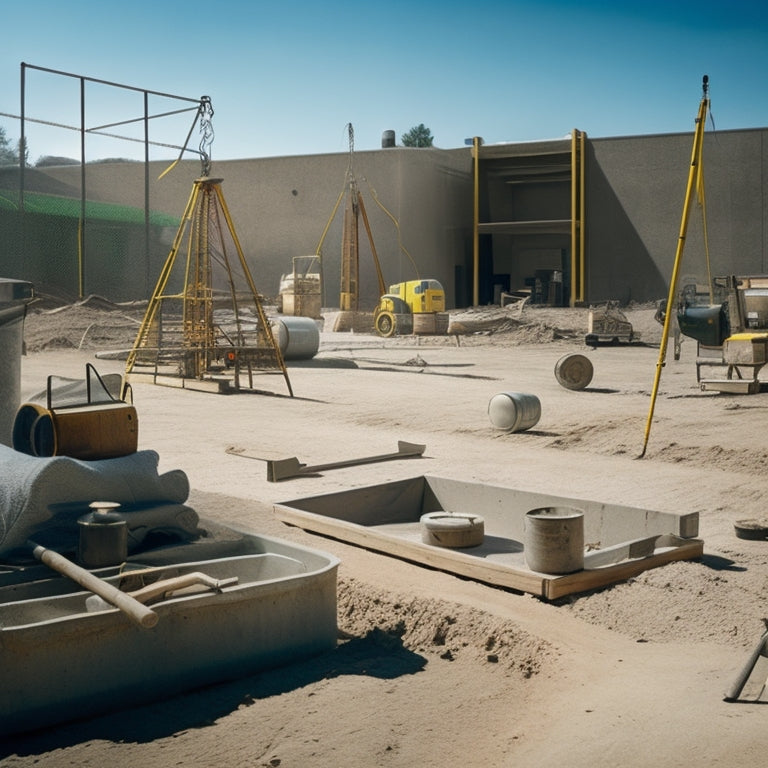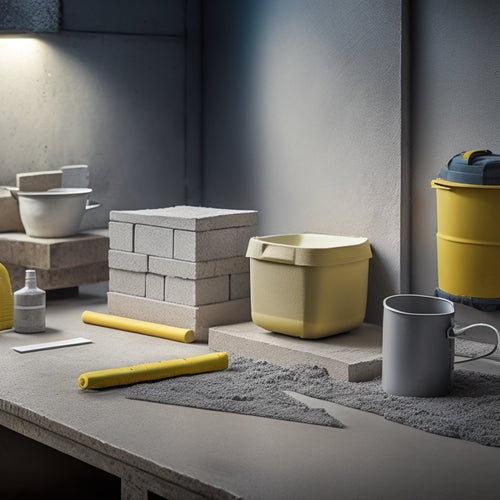
Essential Tools for Concrete Slab Success
Share
When it comes to achieving a strong, durable, and long-lasting concrete slab, having the right tools is essential. You'll need to prepare the site correctly, mixing and pouring the concrete with the right equipment, and finishing and smoothing the surface to perfection. Important tools include a concrete mixer, pouring bucket, screed board, trowel, edgers, and curing compound sprayers. Don't forget safety gear like protective eyewear, dust masks, and sturdy boots. With the right tools, you'll be well on your way to a successful concrete slab project; now, learn how to use them to guarantee a flawless finish and avoid costly mistakes.
Key Takeaways
• Foundation preparation is crucial, involving site clearance, soil testing, and obstruction removal to prevent settlement and cracking.
• Mixing and pouring tools, such as concrete mixers, pouring buckets, and screed boards, ensure a consistent and even concrete flow.
• Finishing and smoothing tools, including high-quality trowels, edgers, and float blades, achieve a flawless surface with precise edges.
• Curing and sealing equipment, like curing compound sprayers and sealing membrane applicators, protect the concrete from environmental factors and damage.
• Safety and protection gear, such as protective eyewear, dust masks, and durable gloves, safeguard workers from hazards and injuries during the project.
Foundation Preparation Essentials
Before pouring a concrete slab, you must confirm the site is properly cleared and graded to prevent settlement and cracking. A thorough site assessment is vital to identify potential issues that could compromise the slab's integrity. This assessment should include a visual inspection of the site, noting any uneven terrain, obstructions, or environmental factors that could affect the concrete.
Soil testing is also a significant component of site preparation. By analyzing the soil's composition and properties, you can determine its load-bearing capacity and potential for settlement. This information will help you design a suitable slab thickness and reinforcement strategy.
Additionally, soil testing can identify any contaminants or hazardous materials that need to be addressed before construction begins. Don't skip these essential steps, as they can save you from costly repairs or even catastrophic failures down the line.
Mixing and Pouring Tools
You'll need a range of specialized tools to mix and pour concrete efficiently, ensuring a strong and durable slab that meets your project's specifications.
A concrete mixer, either a drum-style or tow-behind model, is essential for combining cement, aggregate, and water according to your mixing techniques. Make sure to choose a mixer that can handle the volume of your pour.
Next, you'll need a pouring bucket or chute to transfer the mixed concrete to the slab area. This tool helps maintain a consistent flow and prevents segregation of the mix. For larger pours, consider using a concrete pump to reduce labor and increase efficiency.
When it comes to pouring methods, a screed board or screed pipe is necessary for striking off the excess concrete and achieving the desired elevation. Additionally, a bull float or darby can be used to further smooth and flatten the surface.
Finishing and Smoothing Tools
As you shift from pouring to finishing, a set of specialized tools is required to achieve a smooth, even surface that meets your project's specifications.
Finishing and smoothing tools are designed to help you achieve the desired surface texture and finish. A must-have in your arsenal is a high-quality trowel, which allows you to apply the perfect amount of pressure and control to achieve a smooth finish. Mastering trowel techniques is vital, as it enables you to create a uniform surface texture that's free from imperfections.
Other essential tools include edgers, float blades, and finishing floats, which help you achieve a precise, even edge and a smooth, flat surface.
When selecting finishing and smoothing tools, prioritize durability, ergonomics, and safety features to guarantee a comfortable and accident-free working experience.
Curing and Sealing Equipment
With your freshly finished concrete slab in place, it's time to protect it from the elements and guarantee it develops the necessary strength by applying the right curing and sealing compounds, which is where the right equipment comes in.
To secure a successful concrete slab, you'll need the following curing and sealing equipment:
-
Curing compound sprayers: These are used to evenly apply curing compounds to the concrete surface, promoting proper hydration and strength development.
-
Sealing membrane applicators: These tools help you apply sealing membranes to protect the concrete from water and chemical damage, securing a durable and long-lasting finish.
-
Curing blankets and sheets: These provide a layer of protection against temperature fluctuations, wind, and other environmental factors that can affect the curing process.
Safety and Protection Gear
Gear up for the concrete slab project by donning the right safety and protection gear to shield yourself from the hazards of concrete dust, heavy equipment, and harsh chemicals. You'll need to comply with safety regulations, so make certain you have the essential gear to prevent injuries and guarantee a successful project.
Start with protective eyewear, such as goggles or safety glasses, to safeguard your eyes from flying debris and chemical splashes.
A dust mask or respirator will protect your lungs from inhaling concrete dust and other airborne particles.
Don't forget sturdy boots with good traction to prevent slips and falls, and wear durable gloves to shield your hands from abrasions and cuts.
Additionally, consider wearing a hard hat, especially when working under overhead structures or near heavy equipment.
Make certain your clothing is durable, comfortable, and suitable for the task at hand.
By wearing the right safety gear, you'll be well-prepared to tackle your concrete slab project with confidence and peace of mind.
Frequently Asked Questions
What Is the Ideal Temperature for Pouring Concrete Slabs?
When you're preparing to pour a concrete slab, you need to guarantee the temperature is just right.
You're aiming for an ideal pouring temperature between 50°F and 70°F (10°C and 21°C). This range allows for proper curing and strength development.
Be mindful of weather conditions, too - avoid pouring in direct sunlight, high winds, or during extreme temperature fluctuations.
Can I Use a Concrete Slab for a Treehouse or Deck?
When building a treehouse or deck, you're likely wondering if a concrete slab is a suitable foundation.
While it's technically possible, you'll need to take into account the unique demands of treehouse foundations and deck stability.
You'll require a robust slab design to handle weight distribution, soil settlement, and environmental factors.
It's essential to consult with a structural engineer or experienced contractor to guarantee your concrete slab can safely support your elevated structure.
How Long Does It Take for Concrete to Fully Cure?
Time is of the essence, like a ticking clock, when it comes to concrete curing.
You'll want to allow a minimum of 28 days for the concrete to fully cure, but the reality is, it's a continuous process.
The key is to maintain a consistent moisture retention throughout the curing process.
You'll need to keep the slab moist, either by spraying water or using a curing compound, to guarantee the concrete reaches its full strength and durability.
Is It Necessary to Have a Drainage System Under the Slab?
You're wondering if a drainage system under the slab is necessary. The answer is yes, it's essential.
Without proper drainage solutions, water can accumulate and compromise the slab's integrity. This can lead to cracks, damage, and even safety hazards.
Effective moisture control is key to preventing these issues. By installing a reliable drainage system, you'll guarantee a strong, durable slab that can withstand the test of time and harsh weather conditions.
Can I Pour a Concrete Slab Over an Existing One?
'Don't put the cart before the horse' - it's essential to assess if pouring a concrete slab over an existing one is feasible.
You'll need to evaluate the slab thickness and guarantee the surface preparation is adequate.
If the existing slab is cracked or uneven, it may not provide a stable base. You'll need to repair or replace it before adding a new layer.
Proper surface preparation, including cleaning and bonding, is also critical to secure a strong bond between the old and new concrete.
Conclusion
So, you've made it through the gauntlet of concrete slab construction. Congratulations!
You've got the right tools, the right techniques, and the right mindset.
Now, the only thing standing between you and a flawless slab is... your own fallibility.
That's right, even with the best tools and training, human error can still creep in.
Don't let it. Stay vigilant, stay focused, and remember, a successful concrete slab is only as good as the person building it.
Related Posts
-

Essential Tools for Painting Concrete Walls
When painting concrete walls, you'll need a range of specialized tools to achieve a professional-looking finish. Star...
-

What Tools Do I Need for Concrete Block Laying
You'll need a thorough set of tools to guarantee accurate, efficient, and professional concrete block laying. Essenti...
-

Top Tools for Concrete Repair Success
When it comes to concrete repair success, you'll need a well-stocked toolkit with essential hand tools like trowels, ...


